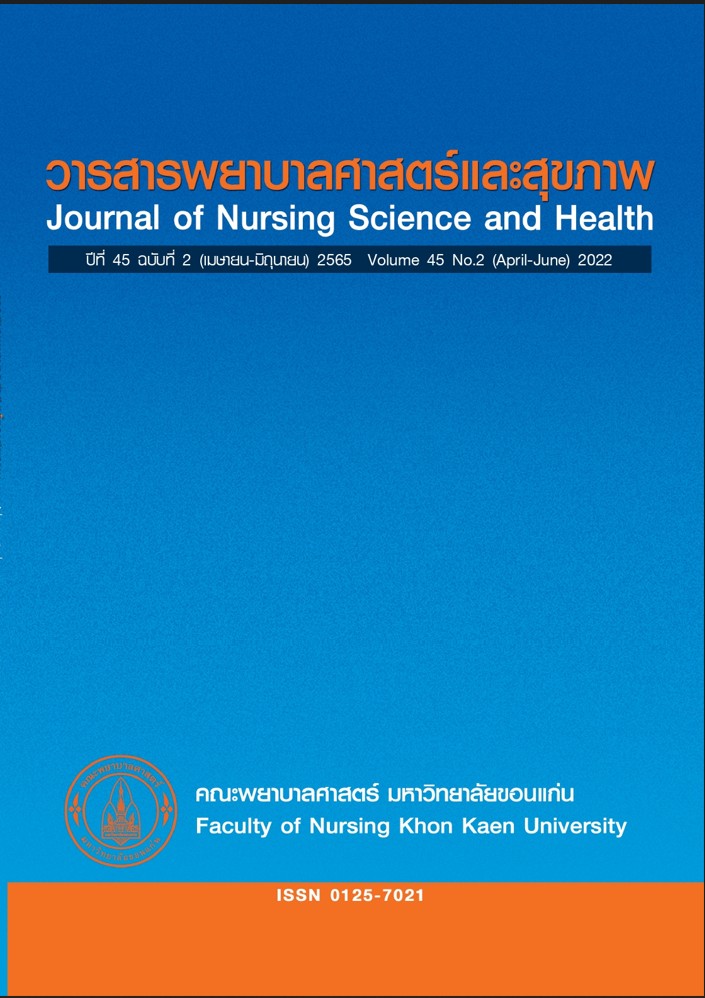ผลของโปรแกรมการจัดการตนเองต่อน้ำหนักตัวที่เพิ่มระหว่างการฟอกเลือด ในผู้ป่วยที่ได้รับการฟอกเลือดด้วยเครื่องไตเทียม ประเทศอินโดนีเซีย
คำสำคัญ:
ภาวะน้ำเกิน, การฟอกเลือดด้วยเครื่องไตเทียม , การเพิ่มของน้ำหนักตัวระหว่างการฟอกเลือด, การจัดการตนเองบทคัดย่อ
จุดมุ่งหมายของการศึกษากึ่งทดลองนี้มีวัตถุประสงค์เพื่อศึกษาผลของโปรแกรมการจัดการตนเองต่อการเพิ่มขึ้นของน้ำหนักตัวระหว่างการฟอกเลือดในผู้ป่วยไตเรื้อรังระยะสุดท้ายที่ได้รับการฟอกเลือดด้วยเครื่องไตเทียมที่โรงพยาบาล Muhammadiyah Lamongan ประเทศอินโดนีเซีย คัดเลือกผู้ป่วยทั้งหมด 40 ราย เข้าร่วมในการศึกษา
นี้ตามเกณฑ์การคัดเข้า สุ่มตัวอย่างเข้ากลุ่มทดลอง (n=20) หรือกลุ่มควบคุม (n=20) กลุ่มทดลองได้รับโปรแกรมเป็นเวลา 5 สัปดาห์เพิ่มเติมจากการดูแลตามปกติ ในขณะที่กลุ่มควบคุมได้รับการดูแลตามปกติเท่านั้น โปรแกรมการจัดการตนเองพัฒนาขึ้นตามแนวคิดการจัดการตนเองของ Kanfer เพื่อส่งเสริมพฤติกรรมการจัดการตนเองด้าน
การควบคุมน้ำในผู้ป่วยไตเรื้อรังระยะสุดท้ายที่ได้รับการฟอกเลือดด้วยเครื่องไตเทียม เครื่องมือวิจัยนี้ได้รับการตรวจสอบความตรงของเนื้อหาโดยผู้เชี่ยวชาญ 5 คน ตลอดจนการให้ข้อเสนอแนะและความคิดเห็นต่อการศึกษาความตรงของเนื้อหามีค่าเท่ากับ 0.96 เก็บรวบรวมข้อมูลการเพิ่มขึ้นของน้ำหนักตัวระหว่างการฟอกเลือดด้วยการชั่งนน้ำหนักตัวผู้ป่วยก่อนและหลังการฟอกเลือดในสัปดาห์ที่ 1 และสัปดาห์ที่ 5 ของโปรแกรม วิเคราะห์ข้อมูลโดยใช้สถิติพรรณนา การทดสอบค่าทีคู่ และการทดสอบค่าทีอิสระ
ผลการศึกษาพบว่าหลังจากเสร็จสิ้นโปรแกรมในสัปดาห์ที่ 5 กลุ่มทดลองมีการเพิ่มขึ้นของน้ำหนักตัวระหว่างการฟอกเลือดน้อยกว่ากลุ่มควบคุมอย่างมีนัยสำคัญ (p=.002) ผลการวิจัยบ่งชี้ว่าโปรแกรมการจัดการตนเองมีประสิทธิภาพในการส่งเสริมการจัดการตนเองเพื่อควบคุมน้ำในผู้ป่วยและช่วยลดการเพิ่มขึ้นของน้ำหนักตัวระหว่างการฟอกเลือด ดังนั้น จึงควรบูรณาการโปรแกรมการจัดการตนเองเข้ากับการปฏิบัติการพยาบาลสำหรับผู้ป่วยไตเรื้อรังระยะสุดท้ายที่ได้รับการฟอกเลือดด้วยเครื่องไตเทียม
เอกสารอ้างอิง
Directorate of control and prevention of non-communicable diseases (P2PTM). Chronic kidney disease. Available from:http://p2ptm.kemkes.go.id/activity-p2ptm/subdit-disease-jantung-dan-perembuluhblood/ginjal-kronis [Accessed 2 February
Indonesian Renal Registry, Indonesian Renal Registry. Indonesia Renal Registry.2018;46.
Ministry of Health Financing and Health Insurance Center, Ministry of Health Financing and Health Insurance Center. Pusat Data dan Informasi - Kementerian Kesehatan Republic of Indonesia [Internet]. 2017 [cited 2020 Oct 13]. Available from:https://pusdatin.kemkes.go.id/article/view/17050400001/situasipenyakit-ginjal-kronis.html.
Howren MB, Kellerman QD, Hillis SL,Cvengros J, Lawton W, Christensen AJ. Effect of a behavioral self-regulation intervention on patient adherence to fluid-intake restrictions in hemodialysis: A randomized controlled trial. Ann behav med 2016;50(2):167–76.
Kalantar-Zadeh K, Regidor DL, Kovesdy CP, Van Wyck D, Bunnapradist S, Horwich TB, et al. Fluid retention is associated with cardiovascular mortality in patients undergoing long-term hemodialysis. Circulation 2009;119(5):671–9.
Movilli E, Gaggia P, Zubani R, Camerini C, Vizzardi V, Parrinello G, et al. Association between high ultrafiltration rates and mortality in uraemic patients on regular haemodialysis. A 5-year prospective observational multicentre study. Nephrology Dialysis Transplantation 2007;22(12):3547–52.
Smith K, Coston M, Glock K, Elasy TA, Wallston KA, Ikizler TA, et al. Patient perspectives on fluid management in chronic hemodialysis. Journal of Renal Nutrition 2010;20(5):334-41.
Office registration Lamongan Muhammadiyah Hospital, Office registration Lamongan Muhammadiyah Hospital, The number of hemodialysi patients at Muhammadiyah Lamongan Hospital; 2016.
Wang H, Naghavi M, Allen C, Barber RM, Bhutta ZA, Carter A, et al. Global, regional, and national life expectancy, all-cause mortality, and cause-specific mortality for 249 causes of death, 1980–2015: A systematic analysis for the global burden of disease study 2015. The Lancet 2016;388(10053):1459-544.
Griva K, Mooppil N, Seet P, Krishnan DSP, James H, Newman SP. The NKF-NUS HD trial protocol - A randomized controlled trial to determine the effectiveness of a self-management intervention for HD patients. BMC Nephrol 2011;12(1):4.
Tong A, Sainsbury P, Chadban S, Walker RG, Harris DC, Carter SM, et al. Patients’ experiences and perspectives of living with CKD. American Journal of Kidney Diseases 2009;53(4):689-700.
Sharp J, Wild MR, Gumley AI. A systematic review of psychological interventions for the treatment of nonadherence to fluid-intake restrictions in people receiving hemodialysis. American Journal of Kidney Diseases 2005;45(1):15–27.
Witchunee Sritong NM. View of effects of self-management program with reminder system via line application to prevent volume overload among patients receiving HD [Internet]. [cited 2022 Feb 11]. Available from: https://he01.tci-thaijo.org/index.php/nah/article/ view/250540/170120
Choi ES, Lee J. Effects of a face-to-face self-management program on knowledge, self-care practice and kidney function in patients with chronic kidney disease before the renal replacement therapy. J Korean Acad Nurs 2012;42(7):1070.
Kanfer FH, Gaelick-Buys L. Self-management methods. In: Elmsford NY, editors, Helping people change: A textbook of methods, 4th ed. US: Pergamon Press; 1991:p.305–60.
Kauric-Klein Z, Peters RM, Yarandi HN.Self-efficacy and blood pressure self-care behaviors in patients on chronic hemodialysis. West J Nurs Res 2017;39(7):886-905.
Nursalam N, Dian Kurniawati N, Priyantini D, Rian Patma Putri I. Automatic reminder for fluids management on confidence and compliance with fluid restrictions in HD patients. SRP [Internet]. 2020 Jun 1 [cited 2022 Feb 13];11(05). Available from: http://www.sysrevpharm.org//index.php?fulltxt=108461&fulltxtj=196&fulltxtp=196-1589897269.
Husain F, Kusuma H, Johan A. Effects of peer support program on self-management in patients with end-stage renal disease under going hemodialysis. Nurs Med J Nursing 2020;10(2):171–81.
Chironda G, Bhengu B. Contributing factors to non-adherence among chronic kidney disease (ckd) patients: A systematic review of literature. Abdelkader Boukerrouche [Internet]. 2016 [cited 2020 Oct 12];02(04). Available from: http://medical-clinicalreviews.imedpub.com/contributing-factorsto-nonadherence-among-chronic-kidneydisease-ckdpatients-a-systematic-review-ofliterature.php?aid=17499.
Mailani F, Bakri SO. The duration of HDtreatment and the adherence of chronic kidney disease patients in fluid intake limitation: A relationship. IJNS 2020;2(1):43-8.
Dantas LGG, de Seixas Rocha M, Junior JAM, Paschoalin EL, Paschoalin SRKP, Sampaio Cruz CM. Non-adherence to haemodialysis, Interdialytic weight gain and cardiovascular mortality: A cohort study. BMC Nephrol 2019;20(1):402.
Jain AK, Blake P, Cordy P, Garg AX. Global trends in rates of peritoneal dialysis. J Am Soc Nephrol 2012;23(3):533-44.
Movilli E, Gaggia P, Zubani R, Camerini C, Vizzardi V, Parrinello G, et al. Association between high ultrafiltration rates and mortality
in uraemic patients on regular haemodialysis. A 5-year prospective observational multicentre study. Nephrology Dialysis Transplantation 2007;22(12):3547-52.
ดาวน์โหลด
เผยแพร่แล้ว
รูปแบบการอ้างอิง
ฉบับ
ประเภทบทความ
สัญญาอนุญาต
ลิขสิทธิ์ (c) 2022 วารสารพยาบาลศาสตร์และสุขภาพ

อนุญาตภายใต้เงื่อนไข Creative Commons Attribution-NonCommercial-NoDerivatives 4.0 International License.
วารสารพยาบาลศาสตร์และสุขภาพเป็นเจ้าของลิขสิทธิ์ในการเผยแพร่ผลงานที่ตีพิมพ์ห้ามผู้ใดนำบทความที่ได้รับการตีพิมพ์ในวารสารพยาบาลศาสตร์และสุขภาพไปเผยแพร่ในลักษณะต่าง ๆ ดังนี้ การนำบทความไปเผยแพร่ออนไลน์ การถ่ายเอกสารบทความเพื่อกิจกรรมที่ไม่ใช่การเรียนการสอน การส่งบทความไปตีพิมพ์เผยแพร่ที่อื่น ยกเว้นเสียแต่ได้รับอนุญาตจากวารสารพยาบาลศาสตร์และสุขภาพ



